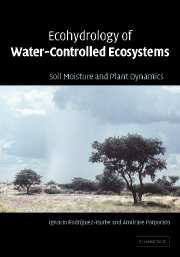Book contents
- Frontmatter
- Contents
- Foreword
- Preface
- 1 Introduction
- 2 Stochastic soil moisture dynamics and water balance
- 3 Crossing properties of soil moisture dynamics
- 4 Plant water stress
- 5 Applications to natural ecosystems
- 6 Coupled dynamics of photosynthesis, transpiration and soil water balance: from hourly to growing-season time scale
- 7 Plant strategies and water use
- 8 Seasonal and interannual fluctuations in soil moisture dynamics
- 9 Spatial scale issues in soil moisture dynamics
- 10 Hydrologic controls on nutrient cycles
- 11 Hydrologic variability and ecosystem structure
- References
- Species Index
- Subject Index
- Plate section
11 - Hydrologic variability and ecosystem structure
Published online by Cambridge University Press: 14 October 2009
- Frontmatter
- Contents
- Foreword
- Preface
- 1 Introduction
- 2 Stochastic soil moisture dynamics and water balance
- 3 Crossing properties of soil moisture dynamics
- 4 Plant water stress
- 5 Applications to natural ecosystems
- 6 Coupled dynamics of photosynthesis, transpiration and soil water balance: from hourly to growing-season time scale
- 7 Plant strategies and water use
- 8 Seasonal and interannual fluctuations in soil moisture dynamics
- 9 Spatial scale issues in soil moisture dynamics
- 10 Hydrologic controls on nutrient cycles
- 11 Hydrologic variability and ecosystem structure
- References
- Species Index
- Subject Index
- Plate section
Summary
Throughout the book we have described various ways in which plants respond to hydrologic forcing: in this last chapter, these elements are put together to analyze the role of hydrologic variability on the space–time ecosystem structure. Vegetation has been observed to exhibit a degree of spatial organization in a number of ecosystems, including rainforests (Sole and Manrubia, 1995), semi-arid grasslands (Milne, 1992), temperate forests (Mladenoff et al.,1993), and savannas (Couteron and Kokou, 1997; Scholes and Archer, 1997; see also Figure 1.10). The emergence of these organized patterns is attributable to a range of temporal and spatial variations in the interaction among species, localized dispersal abilities, and disturbance regimes as well as in the climate and soil characteristics.
Understanding the temporal and spatial patterns of vegetation in semi-arid ecosystems is perhaps one of the most fascinating aspects of ecohydrology. It is a rapidly evolving topic in which a great deal of research is currently being done. As a consequence, what follows is not to be intended as an exhaustive review of the subject, but rather as a discussion of results arising from simplified models with the same explorative spirit of the previous chapters. We just mention other studies that, though not directly dealing with fluctuating hydrologic conditions, might be of interest here (e.g., Klausmeier, 1999; Hellerislambers et al., 2001; Rietkerk et al., 2002; and references therein). Many of these studies have proposed models in which the pattern-forming component is an activation-inhibition mechanism that generates a Turing-type of instability (e.g., Murray, 1989).
Information
- Type
- Chapter
- Information
- Ecohydrology of Water-Controlled EcosystemsSoil Moisture and Plant Dynamics, pp. 360 - 416Publisher: Cambridge University PressPrint publication year: 2005
